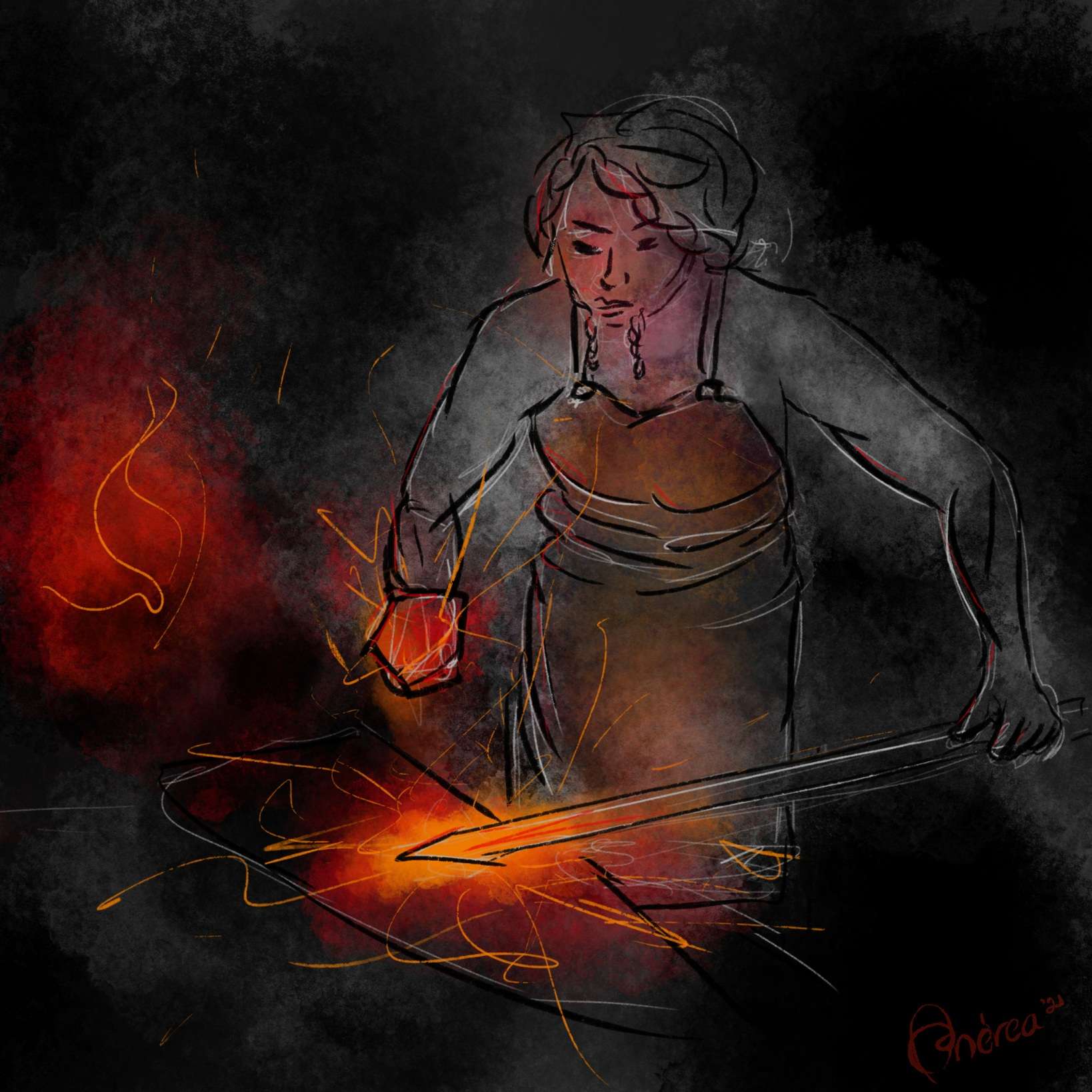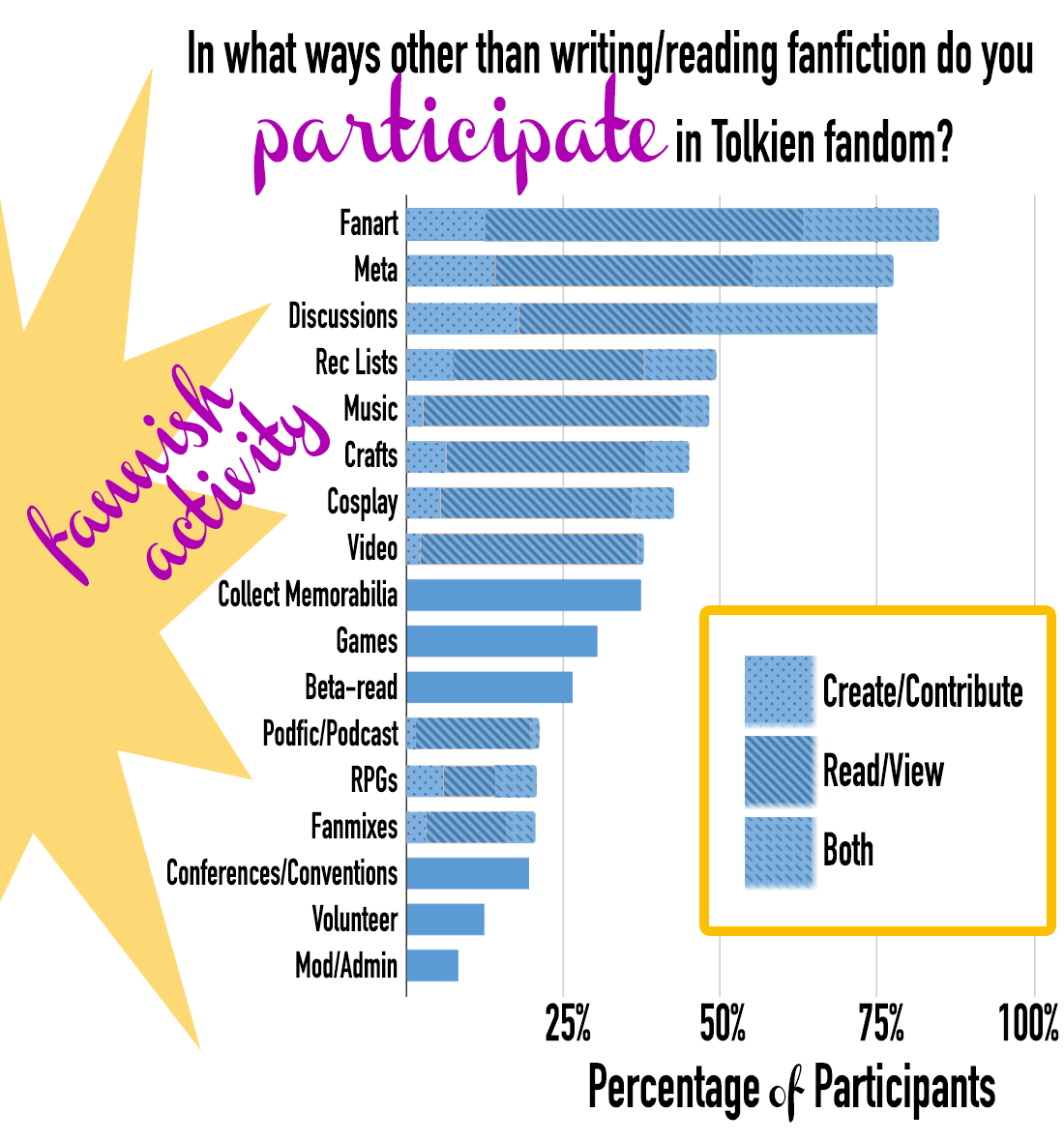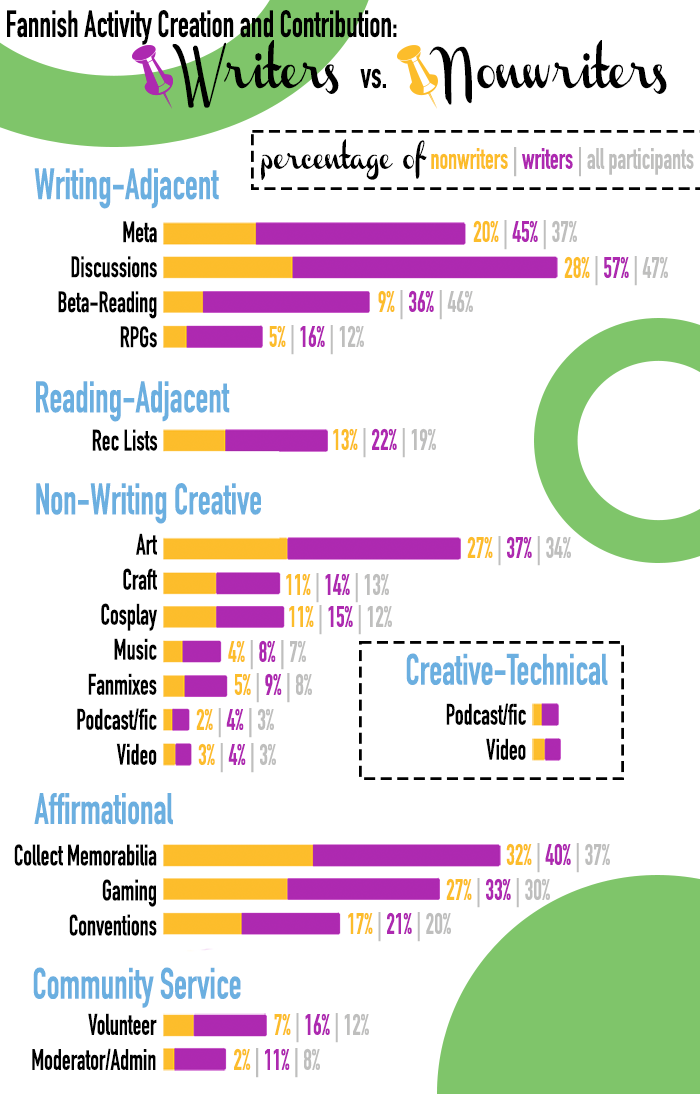Things Tolkien Fanfiction Readers and Writers Like to Do (Other Than Fanfiction) by Dawn Walls-Thumma
Posted on 27 January 2024; updated on 27 January 2024
This article is part of the newsletter column Cultus Dispatches.

The terms fandom and fannish are so broad that they are almost meaningless. People engage—and have always engaged—in every way imaginable with texts that are meaningful to them. Most of us have done something fannish: caught up about a favorite show or author with a colleague, worn a team's clothing before a big game, or purchased an item that represents a text or artist we enjoy.
Fan studies researchers have, in part, sought to classify and find trends among the various modes of fannish expression. One theory that I particularly like is obsession_inc's concepts of affirmational and transformational fandom. Lying at opposite extremes of a continuum, affirmational and transformational fandom represent two different modes of engaging with fandom. (Most of us lie somewhere in the middle, engaging in both to varying degrees.) Affirmational fandom—sometimes called curative fandom—enshrines the authority of the original creator and other traditional authorities (such as editors, publishers, and filmmakers) to determine the "canon" of a text. Transformational fandom, on the other hand, places that authority with fans, whose interpretations and reworkings of a text are seen as having the force of canon, even when they fly contrary to the wishes of the original creator and other traditional authorities. Transformational fandom is associated with creating fanworks and tends to be associated with women and queer fans.
Of course, obsession_inc's continuum isn't the only way to categorize various ways of participating in fandom. Use of technology is another way fannish participation can be classified. Consider, for example, talking or discussing a favorite show or book. One can do that without any technology at all: book clubs, watercooler talk, or casual conversations with friends over dinner and drinks. Technology can also play a role, whether low-tech (such as joining a Discord server) or high-tech (coding a discussion forum). Fandom activities can also be classified according to their level of interaction with other fans: solo, interactive, collaborative, or community-service-oriented—and often a blend of many of these.
When Maria K. Alberto and I ran the Tolkien Fanfiction Survey in 2020, we were curious about how people who read and write fanfiction about Tolkien's world also engage with that world fannishly. The 2020 survey, which had 746 valid responses, included a question about other forms of fannish participation: "In what ways other than writing/reading fanfiction do you participate in Tolkien fandom?" Where the fannish interests of fanfiction participants lie shed light on how this broadly defined community engages with various forms of creative expression, authority, and technology.
General Preferences
First and foremost, among survey participants, about two in three (66%) were writers of Tolkien-based fanfiction. Most of these writers were readers as well; less than 1% of participants wrote fanfiction but didn't read it.
Participants were asked "In what ways other than writing/reading fanfiction do you participate in Tolkien fandom?" and could select from seventeen choices, as well as input additional activities into an "Other" field. The activities from which participants could select are listed below; they could choose as many (or as few) as they wanted. Furthermore, some of the activities (marked with a * in the list below) allowed participants to choose "Create/Contribute," "Read/View," both, or neither.
- Fanart*
- Meta (nonfiction/essays/commentary on original text)*
- Online discussions*
- Music*
- Crafts*
- Recommendation lists (“recs”)*
- Collect Tolkien-related memorabilia or artifacts other than books
- Video*
- Cosplay*
- Play Tolkien-related games
- Beta-read
- Podfic/podcast*
- Fanmixes*
- Attend conferences, conventions, and other offline fan gatherings
- RPGs*
- Volunteer for fandom sites, events, and projects, not in an admin/moderator role
- Coordinate or moderate fandom sites, events, and projects
(Of course, one of the most important—and fraught—fannish activities, commenting on fanworks, is missing from the list because commenting can, and will, form its own article sometime in the future.)
 The graphic to the right shows how many people surveyed also participate in these activities, in addition to reading and/or writing fanfiction.
The graphic to the right shows how many people surveyed also participate in these activities, in addition to reading and/or writing fanfiction.
The list above shows the complexity of obsession_inc's concept of affirmational and transformational fandom, namely that these identifiers are not a binary. I have made this case quite a bit by now, pushing back on the tendency in fan studies to rather breathlessly locate fanfiction writers firmly on the transformational end of the continuum, with all that that implies about fan resistance to oppressive and capitalistic systems. I get it; we want our work—which was widely denigrated for so long—to matter. For fanfiction, which was almost universally treated as crap writing if not a criminal act, to become a mode by which marginalized people reclaim their stolen power epitomizes an underdog story. However, sidelining affirmational fannish expression by fanworks creators doesn't present an accurate picture of how Tolkien fanfiction writers—and many other fandom's writers, I expect—actually engage with the texts as part of creating their stories. As the data show, some of the most common fannish activities, namely meta and discussions, are heavily affirmational. In the context of writing fanfiction, both often occur with the intent of understanding how the canon interacts with creative transformation of that canon into new stories about Arda. In short, both the affirmational and transformational aspects are essential to the act of creating a work of fanfiction.
The two fannish activities most commonly contributed by survey participants were discussions and meta, with 47% and 37%, respectively, choosing "Create/Contribute" for these activities. Fanart is a close third, with 34% creating art, and then the number of participants creating and contributing various other types of fanworks drops off sharply after that, with 19% creating fanwork recommendation lists. Among fanworks viewed and read, fanart takes the lead, with 66% of participants viewing fanart, but meta is close behind, with 63% reading it. 57% read discussions, and the numbers drop sharply again after that point: in fourth place, 46% of participants listen to Tolkien-related music.
Art, meta, and discussion reign supreme among survey participants, therefore, showing the importance of fannish activities that engage directly and often deeply and critically with the canon versus other fans' interpretation of that canon in other creative forms.
Writing-Adjacent
While all survey participants engaged with Tolkien-based fanfiction in some way, as noted above, one in three only read fanfiction and did not write it. Did participation in fannish activities outside fanfiction vary between those who wrote fanfiction and those who didn't?
In short: yes. For each of the seventeen fannish activities on the list, writers participated at a higher rate than nonwriters. These data are not surprising; in order to write fanfiction about Tolkien's world—which requires significant engagement with a complex canon—one is generally fairly invested in Tolkien's world. It is certainly possible to write fanfiction with minimal knowledge of any text, including Tolkien's, but this is not the tendency among Tolkien fanfiction writers. (Becoming Bookverse addresses the trend among fanfiction writers to read more of Tolkien's books as they spend more time writing fanfiction.) Reading Tolkien-based fanfiction, on the other hand, doesn't tend to require the same commitment, and this likely reflects as less involvement in all manner of fannish activities.
The difference between writers and non-writers, however, was most dramatic among activities that I have classified as "writing-adjacent," meaning that they require some degree of comfort with written communication to engage in. For these activities—which include meta, discussions, beta-reading, and roleplaying (RPGs)—writers participate at a much higher rate than non-writers do.
The graphs below show the percentage of writers and nonwriters who engage in creation or contribution for each of the seventeen activities included in the survey. In all cases, the magenta-colored bar is larger than the yellow, showing greater participation among writers—sometimes significantly so. I have classified the activities in various groupings that, as I analyzed the data, revealed interesting trends as far as how fanfiction writers and readers engage with them.

Writing-adjacent activities were more likely to be practiced by fanfiction writers. This is not unexpected. Writing involves a number of processes acting in conjunction: memory and recall, organization of ideas, construction of syntax, critical thinking, control of conventions, and fine motor skills (either handwriting or typing). I am a writing teacher of secondary-age kids, and writing is widely seen in education research as the most cognitively demanding activity required in a student's day. Many people make it to adulthood without becoming fully comfortable in writing, much less finding it enjoyable, so it makes sense that those who do enjoy writing would tend to gravitate to pursuits that also draw on those skills.
There was one activity—making recommendation lists—that I classified as reader-adjacent. Again, however, writers engaged in making recommendation lists more often than nonwriters did, suggesting (as noted above) that the higher participation from writers is more likely due to higher engagement in Tolkien fandom overall.
Affirmational/Transformational
Above, I mentioned that the top three activities practiced and viewed by survey participants—art, meta, and discussions—shows the fertile range of territory between the affirmational and transformational extremes on obsession_inc's continuum. Meta and discussions show how fanfiction writers engaged deeply with Tolkien's canon in a way that would typically be associated with affirmational fans: those interested in mastering the canon or authority-approved version of the story.
The survey also asked about two activities that are generally classified as affirmational: collecting memorabilia and attending conferences or conventions. (In the illustration above, I included gaming here as well, although it is less clear that this is a affirmational activity. I included it because players are not transforming the canon and because at least official games are approved by the Tolkien Estate and other rights holders and so adhere to an authorized vision of Middle-earth. People may want to fight me on this! Feel free to comment below and, if you think I'm wrong, let me know!)
As shown in the data, there is some interest among fanfiction readers and writers in these typically affirmational activities. Collecting memorabilia—the survey specifically excludes books, since many fanfiction writers collect books in order to research for their stories—is the most common, with just over one in three participants engaging in this activity. None of them are especially popular, though; consider that fanart, meta, and discussions are created or viewed by at least three out of four participants, in contrast.
What this suggests to me is that there is some truth behind the affirmational/transformational divide, but it is not that simple. There are affirmational activities—those that value mastery of canon—that are common among fanfiction writers, but not all. Those that support creative activities, like fanfiction, are those that are highly practiced, showing how an inherently transformational activity—creating a transformative work like fanfiction—can in fact have deep affirmational roots.
Technological Skill
In last month's article, Duel of Surveys, I compared data from the Tolkien Fanfiction Survey with data from the OTW's 16th Anniversary Survey. While I continue to caution putting too much into any comparison of two vastly different instruments, one tentative conclusion I drew was that Tolkien fanfiction writers and readers are less inclined to move on from older platforms than fanfiction writers and readers overall. Tolkien fanficcers are like the Galadhrim: They've found their place in the world, they are happy where they are, and they are willing to wield magic to hang onto it. (The SWG itself is proof of that.)
Among the current data, there were two creative activities that I classified as creative-technical: podfic/podcast and video. Working in these formats requires creativity, but they also demand a higher level of technical skill than, for example, writing a work of fanfiction. (Some forms of art are also technologically demanding, but there is no way to suss out which of the 34% of participants who create art are working with tech tools to do so.)
As the graph above shows, creation of technology-heavy fanworks is very low among Tolkien fanfiction readers and writers. I have not been able to find comparable data for fans or fanficcers overall to determine if this is out-of-step with fan practices beyond the Tolkien fandom, but it does bolster my sense that Tolkien fanfiction writers and readers on the whole are not particularly eager to engage with new technology.
Conclusion
The big takeaway from beginning to analyze the data for this question is that all fannish activities are not created equal for fanfiction writers and readers. There are some activities that they prefer over others. In some cases, these are creative or transformational tasks—but not always. Meta and discussion, for example, are among the activities most engaged in, but while they may include creative or transformational elements, they are essentially affirmational, usually originating with an interest in what the facts of the canon are and how they can be interpreted, analyzed, and recombined to arrive at new, inferential knowledge of Arda.
In other cases, other factors come into play. Some activities (such as music) require specialized skill that many fans don't possess to the degree that they create those types of fanworks. Technological skill seems to be a factor as well, and fanworks that require a high level of technological skill tend to be contributed less often than those that are relatively low-tech.


Next, on Cultus Dispataches:…
Next, on Cultus Dispataches: 'Team Tarja, Team Anette or Team Floor: The Siding of Multifandom Tolkien and Nightwish Enjoyers' -> that's what I thought when I first saw the title of this cultus dispatches, I was under the impression it was a survey on people's leisure time, and I thought, 'Man, Dawn sure loves surveys and spreadsheets!'.
"(...)meaning that they require some degree of comfort with written communication to engage in."
It makes sense. Fanfic writers tend to put a lot of research behind transformative work. Which is why I find the dichotomy behind curational/affirmative vs transformative work is redonkulous. But that's a rant for another day.
"Tolkien fanficcers are like the Galadhrim: They've found their place in the world, they are happy where they are, and they are willing to wield magic to hang onto it."
Or Grouchy Book!Thrandy 😃